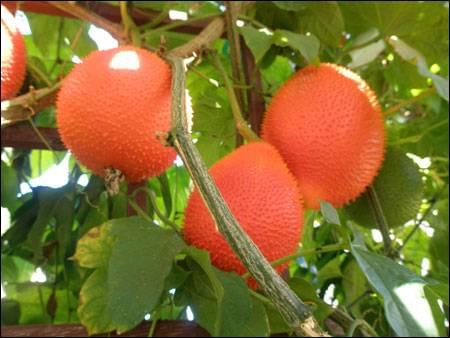Blog
Information of Vietnam Gac Fruit, the fruit from Heaven
Vietnam Gac Fruit Momordica Cochinchinensis, the fruit from Heaven
Vietnam Gac Fruit or Momordica cochin-Chinensis, commonly known as Gac, is a Southeast Asian fruit. It grows throughout the region in Northern Vietnam It is also known as Baby Jackfruit, Spiny Bitter Gourd, Sweet Gourd, or Cochinchin Gourd. It has been traditionally used as both food and medicine in the regions in which it grows.
Because it has a relatively short harvest season (harvest normally starts about 8 months after planting, harvest only lasts for 2 months), making it less abundant than other foods, Gac is typically served at ceremonial or festive occasions in Vietnam.
This probably also accounts for why the fruit is not known better throughout the rest of the world, commercial businesses do not like to deal with fruits in a short season, and the fruit must be ripe when harvested, it cannot be picked green and shipped like bananas.
It is most commonly prepared as a dish called Xoi Gac, in which the aril and seeds of the fruit are cooked in glutinous rice, imparting both their color and flavor.
Gac grows on dioecious vines and is usually collected from fence climbers or from wild plants. This means male flowers on one plant, and female on another, you will probably need about 10 plants to make sure you have a combination of male/female plants. The vines can be commonly seen growing on lattices at the entrances to rural homes or in gardens. It only fruits once a year and is found seasonally in local markets. The fruit itself becomes a dark orange color upon ripening, and is typically round or oblong, maturing to a size of about 13 cm in length and 10 cm in diameter. Its exterior skin is covered in small spines while its dark red interior consists of clusters of fleshy pulp and seeds.
Other than the use of its fruit and leaves for special Vietnamese culinary dishes, Gac is also used for its medicinal and nutritional properties. In Vietnam, the seed membranes are used to aid in the relief of dry eyes, as well as to promote healthy vision.
Similarly, in Traditional Vietnamese and Chinese medicine the seeds of Gac, known as mubiezi, are employed for a variety of internal and external purposes. Recent attention is also beginning to be attracted in the West because of chemical analysis of the fruit suggesting that it has high concentrations of several important phytonutrients.
Gac has been shown to be especially high in lycopene content. Relative to mass, it contains up to 70 times the amount of lycopene found in tomatoes. It has also been found to contain up to 10 times the amount of beta-carotene of carrots or sweet potatoes. Additionally, the carotenoids present in Gac are bound to long-chain fatty acids, resulting in what is claimed to be a more bioavailable form. There has also been recent research that suggests that Gac contains a protein that may inhibit the proliferation of cell damage problems.
Vietnam Gac Fruit Index
Carotenoids in plants are the primary source of vitamin A worldwide. The most efficient pro-vitamin A carotenoid is beta-carotene which is abundant in yellow and orange fruits, such as mangoes, papayas, and yams, and in green leafy vegetables such as spinach, kale, sweet potato leaves, and sweet gourd leaves.
Consumption of foods rich in b-carotene theoretically can replete individuals to a healthy vitamin A status. Gac is remarkably high in beta-carotene and is an outstanding potential resource as a natural cure for Vitamin A deficiency.
It could be said that the Vietnamese people have the lightest, smoothest, and healthiest skin of all Asian races. Recent scientific studies have demonstrated the skin rejuvenating, toning, and youth-enhancing benefits of Gac oil and recent products have been introduced to capitalize on this.
What does Gac taste like?
Gac flesh and oily sacs are quite palatable and have very little taste, it could be described as a very mild taste, in the same way, that a cucumber has very little taste. It is only slightly sweet or not sweet, and it would not be described as delicious, more like plain or no taste. The mesocarp (light orange outer fleshy part under the spiny skin) has a soft spongy texture. It is normally discarded (composted!). When the seeds and oil sac are cooked with rice, they impart a lustrous appearance and oil-rich, mild nutty flavor to the rice.
For western diets, a convenient way to prepare Gac is to drop the seed sacs into a pot of tomato sauce and cook briefly. Of course, if your tomato sauce already has a rich tomato taste and contains some other healthy oils like olive oil, the Gac imparts almost no detectable flavor to the tomato sauce while turbocharging it with Phyto-nutrients. Use it to make some pizza or lasagna!


